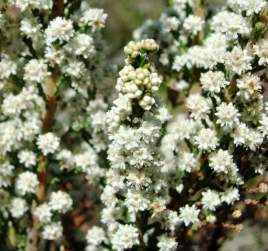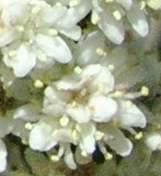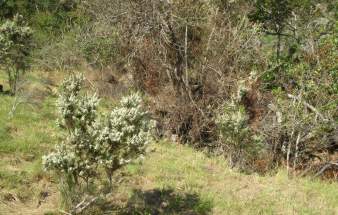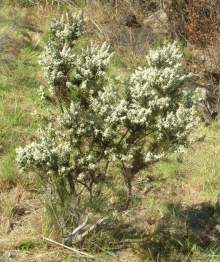Raspalia trigyna
Raspalia trigyna (Schltr.) Dümmer
Family: Bruniaceae
Common names: Pondoland ghost bush
Introduction
The flowering plant family Bruniaceae is almost entirely endemic to fynbos, the typical vegetation of the Cape Floral Kingdom of the Western and Eastern Cape, except for one species, Raspalia trigyna. The Pondoland ghost bush appears completely out of place in its present-day home in the grasslands of the Pondoland region of the Eastern Cape and southern KwaZulu-Natal. It is thought to be a relict of a fynbos-like vegetation that stretched all the way from the Western Cape to KwaZulu-Natal during a former cooler, wetter period about 18 000 years ago-and is now struggling to survive in a much altered environment.

Description
Description
Raspalia trigyna is a perennial, woody shrub up to 2 m tall. In appearance it closely resembles the finely branched, small-leaved shrubs so typical of fynbos. Branches are tightly packed with tiny oval leaves, about 1.0-1.25 mm long. The upper leaf surface is smooth, the leaf margins are curved towards the underside, and the undersides are minutely hairy.

When Raspalia trigyna flowers during July and August, the shrub is entirely covered in masses of minute white flowers. Solitary flower heads are about 2-5 mm wide and develop at the tips of branchlets. A number of cup-shaped flowers with five petals, each 1.0-1.25 mm long, are clustered within each flower head. Five stamens, that are as long as, or slightly longer than the petals, protrude from the flower and are tipped with prominent yellow anthers. One to two small round seeds are produced within a dry fruit capsule.

Conservation Status
Status
Raspalia trigyna has often been called 'South Africa 's rarest shrub' and has been thought extinct a number of times, only to be 'resurrected' again by the discovery of a few more individuals. Raspalia trigyna was first discovered in 1884 near Murchinson in KwaZulu-Natal and in 1900, Thomas Robertson Sim, District Forest Officer in charge of the conservation of forests of the Eastern Cape, wrote that R. trigyna is abundant along streams above Magwa Gorge near Lusikisiki in the Eastern Cape.
The species was not seen again until a single plant was discovered in the Umtamvuna Nature Reserve in 1965. It appeared that over the years, habitat loss to sugarcane and urban development in southern KwaZulu-Natal, forestry, tea plantations and excessive burning of grasslands in the Eastern Cape, but also possibly a natural decline due to reproductive failure, have decreased the population of Raspalia trigyna to critically low numbers. A number of enthusiastic amateur botanists from the Port Edward area kept a lookout for more individuals for many years, but none was ever found and in 1988 the only known plant of R. trigyna died. During August of that same year, peak flowering time for R. trigyna, an expedition was organized to search the Pondoland region for any other surviving individuals. Again, a single plant was found near Magwa Falls. Cuttings were grown from this plant and introduced into the two main reserves protecting the flora of the Pondoland region, Umtamvuna and Mkambati. In 1995, however, it was discovered that the single wild plant at Magwa Falls had also died, and R. trigyna was again considered extinct!
However, in August of 1996, two living plants were found, overlooked for many years, above a little stream in the Umtamvuna Nature Reserve. These plants remained the only known wild individuals of Raspalia trigyna for many years until one other plant was found at Mkambati in 1999. Although alive, R. trigyna remained on the brink of extinction. The few isolated, old individuals that remained are incapable of producing offspring because of this species' reliance on cross pollination. Individuals grown from cuttings and introduced into Umtamvuna and Mkambati failed to remedy the situation. It was only a matter of time before these last plants also died.
Therefore the discovery of a small, but healthy population of mature individuals as well as seedlings near the Mkambati Nature Reserve in 2001 brought great excitement and hope for the future survival of South Africa's rarest shrub. However, because of the very small numbers of individuals remaining in the wild, Raspalia trigyna remains in severe danger of extinction, and has been listed as Critically Endangered on the national Red List of threatened plants of South Africa.
A breeding programme to grow more individuals from seeds and cuttings from the healthy population is in place, and plants are being reintroduced into suitable habitat in the Pondoland region.
Distribution and habitat
Distribution description
Raspalia trigyna is endemic to Msikaba Formation Sandstone, the unique geological formation of the Pondoland Centre of Endemism that is only found along the Eastern Cape Wild Coast from Port St Johns northwards to southern KwaZulu-Natal as far as Oribi Gorge. Among the Bruniaceae, R. trigyna is truly isolated in its distribution. The other closest members of the genus occur more than 1000 km away in the highest peaks of the Langeberg near Riversdale in the Western Cape. The other nearest members of the family Bruniaceae, three species in the genus Berzelia, occur as far east as Grahamstown in the Eastern Cape, which represents a disjunction of about 400 km.
Raspalia trigyna occurs in a highly specific habitat within the grasslands of Pondoland. It prefers cool, sheltered sites near stream banks, often at the edges of seepages.
Derivation of name and historical aspects
History
The first species in the family Bruniaceae were described in 1679, but the family was only established in 1818 by Robert Brown, a British botanist and assistant to Sir Joseph Banks, who is responsible for discovering and introducing to the western world the flora of Australia. They stopped at Cape Town for a plant collecting expedition in October 1801 on route to Australia. The family is named in memory of Dr Alexander Brown, a ship's surgeon, collector of plants along the trade routes of the East India Company including South Africa, and friend of Robert Brown.
The Bruniaceae is a small family consisting of 76 species in 12 genera according to a revision by Pillans published in 1947 and followed in A checklist of South African plants (Germishuizen et al. 2006). However, in Goldblatt & Manning (2000), only 65 species are recognized. Evidence in pollen morphology and wood anatomy indicates that the Bruniaceae is an ancient family. Its relation to the plant families of today is very uncertain, and its closest relatives may be now long extinct primitive flowering plants known only from fossilized material from the Cretaceous Period. Many species in the family, especially in the genus Raspalia are extremely rare and one species, Thamnea depressa, is extinct. The Bruniaceae are considered 'palaeoendemics'-the last remaining descendants of a formerly much larger, more common and widespread family. About three quarters of the species we know today lack reproductive vigour and appear to be in a retrogressive, senescent state and are probably on their way to natural extinction.
According to Pillans's classification, Raspalia is the largest genus in the family with 16 species (only nine in Goldblatt & Manning 2000) and is named in honour of Francois-Vincent Raspail (1794-1878), a French politician and self-taught scientist credited as one of the founders of cell theory as well as establishing modern ideas on health and hygiene.
Raspalia trigyna was described in 1898 by Rudolf Schlechter and the specific epithet trigyna refers to the flowers having three styles and an ovary with three chambers. It appears, however, that Schlechter must have examined abnormal material, as all known specimens collected since have only two-chambered ovaries.

Ecology
Ecology
All known sites where this species occurs are protected from fires. It appears that Raspalia trigyna is sensitive to fire. This is an interesting characteristic of a fynbos relative, as fynbos species are renowned for their dependence on fire for regeneration. However, most of the rarest members of the Bruniaceae, although they occur in fire-frequented fynbos vegetation, also appear to be sensitive to fire and occur in extremely rocky sites in the highest peaks of mountains where fires generally do not reach.
Raspalia trigyna is insect pollinated and dependent on cross pollination for successful seed production. This characteristic is an additional barrier to its continued survival as this species becomes rarer as the opportunities for cross pollination are becoming critically low. Despite the introduction of cloned plant material to support reproduction in the two wild plants remaining in the Umtamvuna Nature Reserve, no seedlings have appeared in this population to date.
Uses
Use
No uses for this species have been recorded.

Growing Raspalia trigyna
Grow
Raspalia trigyna is not available commercially in cultivation and is extremely difficult to grow. Seeds are very scarce, and attempts to grow plants from seed have been unsuccessful. Plants have been cultivated from cuttings, but the cultivation of R. trigyna is at present aimed only at introducing individuals into the natural habitat to attempt to boost the numbers and reproductive success of wild plants.
References
- Abbott, T. 1996. Woody plants of the Pondoland Centre: Raspalia trigyna- the ghost of the Pondoland Centre. Trees in South Africa 56: 8-10.
- Abbott, T. 2003. The story of the Pondoland ghost bush. http://www.safcei.org.za/wildcoast/raspalia_story.htm.
- Abbott, T. 2006. The story of the Pondoland Centre. PlantLife 33 & 34: 5-72.
- Arkell, J. 1995. The quiet extinction of Raspalia trigyna. PlantLife 13: 19, 20.
- Arkell, J. 1996. South Africa 's rarest shrub lives! PlantLife 14: 24.
- Germishuizen, G., Meyer, N.L., Steenkamp, Y. & Keith, M. (eds). 2006. A checklist of South African Plants. Southern African Botanical Diversity Network Report No. 41. SABONET, Pretoria.
- Goldblatt, P. & Manning, J.C. 2000. Cape plants. A conspectus of the Cape flora of South Africa. Strelitzia 9. National Botanical Institute, Cape Town.
- Hall, A.V. 1987. Evidence of a Cretaceous alliance for the Bruniaceae. South African Journal of Science 83: 58, 59.
- Pillans, N.S. 1947. A revision of Bruniaceae. Journal of South African Botany 13: 121-206.
- Quint, M. & Classen-Bockhoff, R. 2006. Phylogeny of Bruniaceae based on matK and ITS Sequence Data. International Journal of Plant Sciences 167: 135-146.
- Scott, G. 1989. Bravo for the Bruniaceae. Veld & Flora 75: 105, 106.
- Van Wyk, A.E. & Smith, G.F. 2001. Regions of floristic endemism in southern Africa. Umdaus Press, Hatfield, Pretoria.
- Weiner, D.B. 1959. Francois-Vincent Raspail: doctor and champion of the poor. French Historical Studies 1: 149-171.
Credits
Lize von Staden
Threatened Species Programme
May 2008
Plant Attributes:
Plant Type: Shrub
SA Distribution: Eastern Cape, KwaZulu-Natal
Soil type: Sandy
Flowering season: Winter
PH: Acid
Flower colour: White
Aspect: Full Sun
Gardening skill: Challenging
Special Features:
Horticultural zones








Rate this article
Article well written and informative
Rate this plant
Is this an interesting plant?
Login to add your Comment
Back to topNot registered yet? Click here to register.